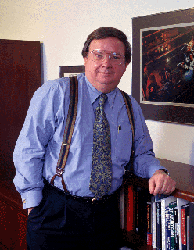

 FOR MORE THAN 50 YEARS, the Department of Energy's science and technology
laboratories have adapted to changing national
priorities, literally redefining "business as usual" along the way. Success
means anticipating the future and embracing the opportunities it presents.
FOR MORE THAN 50 YEARS, the Department of Energy's science and technology
laboratories have adapted to changing national
priorities, literally redefining "business as usual" along the way. Success
means anticipating the future and embracing the opportunities it presents. At Lawrence Berkeley Laboratory, we have done just that. While maintaining our traditional mission of pursuing energy research in its most comprehensive sense, we have positioned ourselves to play a major role in the mandate to preserve a competitive advantage for American science and technology.
We call this report "Today's Science -- Tomorrow's Technology" to reflect the dynamic relationship between discovery and application. This brief overview attempts to illustrate, through our noteworthy successes in 1994, the ways in which LBL's people and facilities contribute to the technology life cycle that begins with a scientist's curiosity and concludes with problems solved.
For our industrial and university partners, sophisticated user facilities such as our new Advanced Light Source and the National Center for Electron Microscopy provide wondrous tools for exploring the atomic world. Our Center for X-ray Optics uses fluorescence to measure metals in contaminated wetlands, a key step in environmental clean-up efforts. The same methodology can be used to find impurities in products such as newly manufactured solar cells. Similarly, electron microscopy has become the keystone in materials science, a field of myriad potential technologies -- from thin films that can be used for the detection of biological pathogens, to nanocrystals of gallium arsenide that one day may be used to make electronic devices a thousand times smaller than today's computer chips.
The biosciences have also become a strategic focus at LBL, highlighted by our Human Genome Center, which developed a novel sequencing approach last year. The Center continues at the forefront of a nationwide commitment to decipher the genetic code, contributing to the development of improved methods for screening genetic abnormalities, locating cancer genes, and diagnosing tumors.
In our energy and environment program, LBL research teams already recognized for their contributions in efficient lighting, windows and building climate technologies are continuing to break new ground. One such breakthrough is the energy-saving, ultra-bright sulfur lamp. Developed in partnership with industry, these lamps promise to alter the course of electrical lighting well into the future.
LBL maintains its position as an international leader in basic science research, the seed of technological advancement. Its preeminence in high-energy physics was never more apparent than last spring, when LBL researchers, as part of an international collaboration of scientists, announced the first experimental evidence for a subatomic particle known as the "top quark"--a missing piece in the scientific picture of the components of matter. LBL has also played a crucial role in the development of the B-factory at Stanford. And when gammasphere--a new high-resolution gamma ray detector--is fully operational, it will attract physicists from around the world to study nuclear structure and exotic nuclear shapes.
This is just a fraction of the scientific excitement generated at LBL in 1994 within our 14 divisions and program centers. In addition, we initiated efforts to improve the effectiveness of our managers, to standardize our cost-accounting procedures, and to measure our performance in a range of administrative and operational areas. These endeavors are central to the University of California's new contract with DOE, and to LBL's own strategic planning process.
They are also part of the fascinating mosaic of people, technological resources and partnerships that adds value to our region, our state and our nation. And no partnership is more important than the historic alliance between the Laboratory and the University of California. Our dynamic mix of academic excellence and technical infrastructure will continue to be an explosive catalyst for new initiatives that address industrial and national research needs.
"Today's Science -- Tomorrow's Technology" is more than a philosophy. It is a commitment to navigate what Vannevar Bush a half century ago called "the endless frontier." Through solving complex problems and uncovering the secrets of the universe, LBL applies scientific excellence for the public good.
Dr. Charles V. Shank is the director of the Lawrence Berkeley Laboratory

Return to the Table of Contents of the 1994 Regents Report
Go to Introduction & Welcome to LBL
